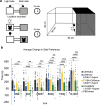Optogenetic restoration of high-sensitivity vision using ChRmine- and ChroME-based channelrhodopsins
- PMID: 40592887
- PMCID: PMC12217448
- DOI: 10.1038/s41598-025-04286-9
Optogenetic restoration of high-sensitivity vision using ChRmine- and ChroME-based channelrhodopsins
Abstract
Optogenetic gene therapy is a promising mutation-independent treatment that aims to restore visual perception in patients blinded by retinal diseases that cause photoreceptor degeneration. Still, low sensitivity or slow kinetics of currently utilized optogenetic proteins limit the efficacy of such approaches. Here, we evaluated the therapeutic potential of three channelrhodopsin variants: ChRmine, from the algae Rhodomonas lens, ChRmine-T119A, a faster-closing ChRmine variant, and ChroME2s, a second-generation Chronos-based opsin.We expressed these opsins in retinal ganglion cells of rd1 mice, a model of severe retinal degeneration. Single cell electrophysiology demonstrates opsin's large sensitivity to a range of light intensities as well as opsin-expressing retinal ganglion cells generated action potentials in response to light stimulation. Behavioral tests showed ChRmine-T119A's efficacy at 360 lux compared to unmodified ChRmine and ChroME2s. ChRmine and ChroME2s did restore light perception at higher light intensities. Additionally, our dose-response study with ChRmine-T119A revealed that lower viral titers were more effective at restoring light sensitivity. Our study demonstrates that these ChRmine- and ChroME-based opsins can enhance vision in late-stage blinding diseases.
Keywords: Channelrhodopsin; Electrophysiology; Gene therapy; Mouse behavior; Optogenetics; Retinal disease; Vision restoration.
© 2025. The Author(s).
Conflict of interest statement
Declarations. Competing interests: The authors declare no competing interests. Ethics statement: The animal study was approved by the Animal Care and Use Committee (ACUC) at University of California, Berkeley. The study was conducted in accordance with the local legislation and institutional requirements.
Figures




References
-
- Ku, C. A. & Pennesi, M. E. The new landscape of retinal gene therapy. Am. J. Med. Genet. C Semin. Med. Genet.184, 846–859 (2020). - PubMed
-
- Botto, C. et al. Early and late stage gene therapy interventions for inherited retinal degenerations. Prog. Retin. Eye Res.86, 100975 (2022). - PubMed
-
- Puthussery, T. & Taylor, W. R. Functional changes in inner retinal neurons in animal models of photoreceptor degeneration. Adv. Exp. Med. Biol.664, 525–532 (2010). - PubMed

